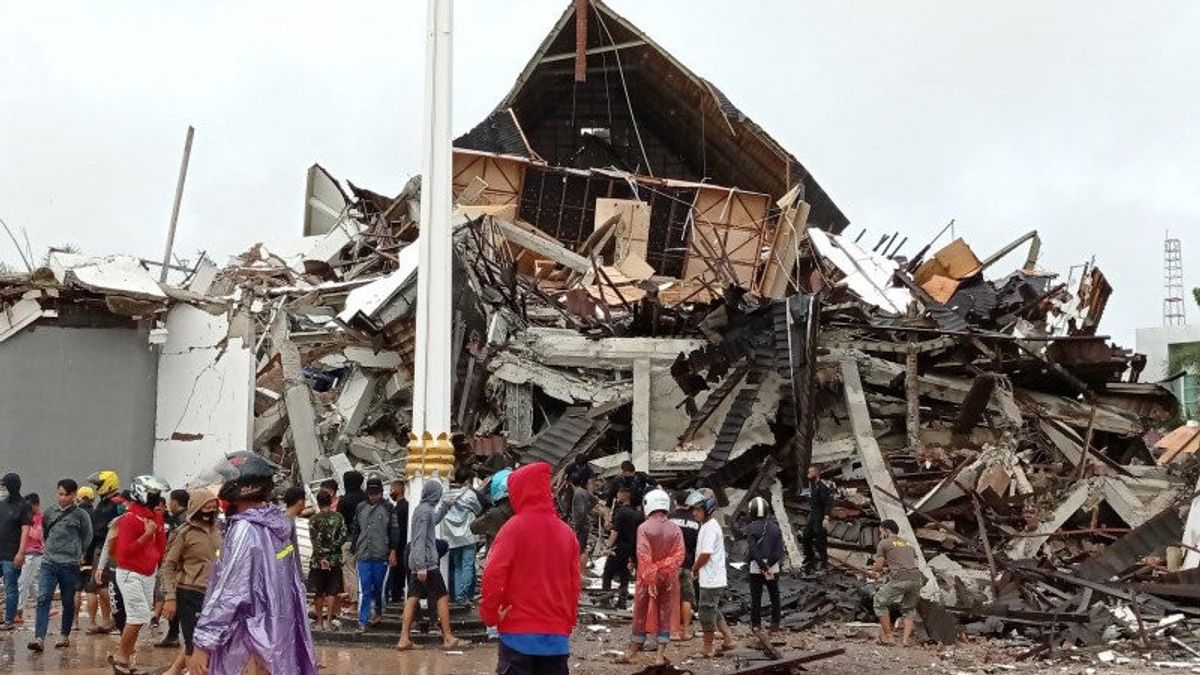JAKARTA - The area of Mamuju, West Sulawesi, on Thursday, January 14, at around 13.35 WIB was shaken by an earthquake with a magnitude of 5.9.
Reported by Antara, Friday, January 15, based on the results of analysis by the Meteorology, Climatology and Geophysics Agency (BMKG), it shows that the epicenter of the earthquake is located at the coordinates of 2.99 South Latitude (LS) and 118.89 East Longitude (BT), or precisely located at land at a distance of 4 km northwest of Majene, West Sulawesi, at a depth of 10 km.
Based on the estimation of the shock level map published by the BMKG, it appears yellow, which means that the earthquake shocks reach an intensity scale of VI MMI which is potentially damaging.
The VI Scale Modified Mercalli Intensity (MMI) means that earthquake vibrations are felt by all residents. Most of the residents were shocked and ran out of the building, falling plaster of the walls and the chimney on the factory was damaged, minor damage.
The MMI scale was recorded up to XII which means that the impact of the earthquake caused complete destruction, visible waves at ground level. The scene darkened and objects were thrown into the air.
All BMKG estimates are proven in the field. It was reported that while there were many damages to people's houses in Majene Regency. Not only damaging, this earthquake also triggered a collateral hazard in the form of rock falls on hilly cliffs.
The community hoped to sleep peacefully, but lindu with greater strength began to shake again on Friday, January 15, at 01.28 WIB. BMKG noted that the earthquake had a magnitude of 6.2.
The epicenter of the earthquake was located at coordinates 2.98 South Latitude and 118.94 East Longitude, or to be precise located on land at a distance of 6 km northeast of Majene, West Sulawesi, at a depth of 10 km.
Because the power is greater, of course, it also has a more destructive impact. Especially if the condition of the building impacted by the earthquake on the previous day has been cracked or partially damaged, then a stronger earthquake can have a more severe impact.
By paying attention to the location of the epicenter and the depth of the hypocenter, both earthquakes are shallow crustal earthquake due to active fault activity.
It is suspected that the trigger for the earthquake was the Mamuju Up Fault (Mamuju Thrust). It is proven that the analysis of the source mechanism shows that the earthquake has a thrust fault mechanism.
This upward fault mechanism is similar to the Lombok earthquake generator in 2018, the fault plane forms the slope of the fault plane to the mainland.
The Mamuju Ascend Fault has a targeted magnitude of 7.0 with a shear rate of 2 mm / year, so this fault must be watched out for because it can trigger strong earthquakes.
Based on the records of the BMKG's Earthquake and Tsunami Mitigation Coordinator, Daryono, the Mamuju or Mamuju thrust upward fault is a very active offshore fault, with upward movement of the fault.
Recurring EarthquakesBMKG Earthquake and Tsunami Center Head Bambang Setiyo Prayitno said that the epicenter of the Majene Earthquake January 14-15, 2021 was very close to the source of the earthquake that triggered the tsunami on February 23, 1969 with a magnitude of 6.9 at a depth of 13 km.
Based on BMKG records, there have been three destructive earthquakes and tsunamis around Majene, namely on April 11, 1967 with a magnitude of 6.3 in Polewali Mandar which killed 13 people.
Then on February 23, 1969 in Majene with a magnitude of 6.9, 64 people died, 97 were injured and 1,287 houses were damaged in four villages. The earthquake caused a tsunami as high as four meters in Pelattoang and 1.5 meters in Parasanga and Palili.
Then the earthquake occurred on January 8, 1984 with a magnitude of 6.7 in Mamuju but there was no record of casualties, but many houses were damaged with a maximum intensity of VII MMI.
Mamuju-Majene Thrust regained its energy with a significant earthquake after a long sleep.
Even the Head of BMKG Dwikorita Karnawati also warned about the possibility of aftershocks with significant strength.
It is feared that aftershocks could potentially cause a tsunami because the rock condition has been shaken by the previous earthquake and is already fragile because the epicenter is on the coast, allowing landslides to occur under the sea.
Based on temporary data from the National Disaster Management Agency (BNPB) until Friday (15/1) at 14.00 WIB, 34 people died as a result of the earthquake in West Sulawesi with details of 26 people dying in Mamuju Regency and eight people in Majene Regency.
Apart from casualties, the earthquake also caused damage. Quite a few houses and buildings in Mamuju collapsed by the earthquake.
As a country that is prone to earthquakes, the infrastructure that should be built must meet the earthquake-resistant building code so that earthquake disasters that take lives are not happening again.
Because the earthquake did not kill, but casualties fell as a result of collapsed buildings.
The community must also be more vigilant and alert by increasing disaster mitigation, including against earthquake events, especially strong earthquakes that have the potential for a tsunami.
Evacuation routes should be prepared for residents living on the beach and awareness for independent evacuation without waiting for the early warning system if a large earthquake occurs. Residents must immediately leave the coast to a higher place and are safe from the tsunami.
The English, Chinese, Japanese, Arabic, and French versions are automatically generated by the AI. So there may still be inaccuracies in translating, please always see Indonesian as our main language. (system supported by DigitalSiber.id)










